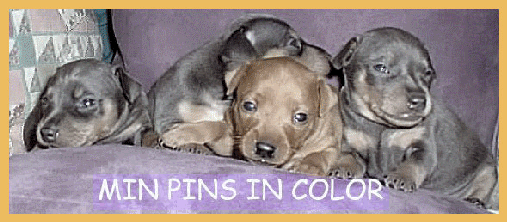| "Miniature Pinschers In Color" by Benji Cato  Miniature Pinschers: In Color! Today's Colors: According to the American Kennel Club and the Miniature Pinscher Club of America, Miniature Pinschers are: red (clear solid red); stag red (solid red with intermingling black hairs); black & rust, or black & tan (black with rust or tan points); and chocolate & rust. or chocolate & tan (chocolate with rust or tan points). These are designated as the "standard" breed colors which are eligible to be shown in competition in the United States. (AKC MINIATURE PINSCHER BREED STANDARD) Other colors, registerable with the AKC, but not considered a standard color and thus, ineligible for the show ring in the U.S., are: blue and tan, or blue and rust (blue with rust or tan points). Blue Min Pins are competitive in the show ring in Britain. Britain has a much longer history than the United States, in breeding the blue colored Ministure Pinscher. (One American bred blue & rust colored Miniature Pinscher, Prancelots Double R Kray At Dobenar {Reggie}, is now competing in England, winning his first show on July 20, 2003). Historically, the Miniature Pinscher Club of America did recognize blue as a "standard" color of Min Pin, though the blues were taken out of the standard in 1950. Mary Boohrer Summers, who had joined MPCA in 1955. said that "the blues were taken out of the standard because of their consistent coat problems and their lack of quality". In 1995, another MPCA board member had this to say; "that the major concern of the Officers and Members of the Board was the color mutant alopecia." (For more details, see: MPCA Coat & Color, and Alopecia). Miniature Pinschers may also be: fawn and rust, or fawn and tan (different ranges of silver with rust or tan points). In the Doberman Pinscher, this color is often referred to as Isabella Fawn. Another color that Miniature Pinschers of today are seen in is a "dilute" of red, which may be referred to as tan, yellow, or even confusingly by some, as a "solid fawn" or "champagne fawn". The problem with calling the diluted red color a solid "fawn", is that it is unrelated in appearance or color orgin to the color considered fawn with rust or tan markings (Isabella), a dilute of the chocolate color which has been much more established as a color named fawn for the Min Pin breed. Calling both of these individual colors by the same name may lead to some confusion in differentiating between the two. The color fawn is not available as a registerable color with the AKC in the Miniature Pinscher breed, so when registering a Min Pin of this color with the AKC, one must choose an alternative color out of the AKC color codes available for the Miniature Pinscher. The closest one might get to describing this color and markings using the AKC color codes would probably be tan with tan markings. (See these codes listed below). The dilute reds were formerly recognized by the MPCA as the standard color yellow, though if registered today, would simply be indicated as red or tan (since yellow is no longer an available color). (The blue and fawn colors are often referred to as "dilute colors". Like the "dilute of red" color, they stem from diluted genes of standard colors. Blue is a diluted color of black, and fawn is a diluted color of chocolate. In the United States, knowledgeable Miniature Pinscher breeders are aware of the coat problem that those of dilute color are susceptible to. They are determined in their efforts to consciously eliminate the gene which causes it from their breeding stock. Many have met with great success.) Historic Colors Formerly, the MPCA also recognized harlequin (black and white flecked dapple or tri-white with black and blue patches) as a standard breed color. Harlequin and yellow were removed from the breed standard at the same time as the blues. Brindle (dark streaks or flecks on a gray or tawny ground) coated Min Pins have also been seen, as well as solid black , solid chocolate, or solid red with a chocolate nose. They also came in a color combination known as merle (blue with black patches, like a Dachsund or Great Dane). White Miniature Pinschers, though rare, have appeared in litters, though there has been some controversy among breeders, concerning whether they are a true color of white, or just a very diluted version of red. A truly white Miniature Pinscher would be an albino, complete with red eyes. While a "white" Miniature Pinscher, assimilar to what is often termed as "white" in the Doberman Pinscher, is actually cremello with white markings. (Cream and White Doberman Pinschers, called white, have a masking gene. The masking gene covers up the markings that the Doberman would have been with out the masking gene. This makes them appear Cream with White points, and they have blue eyes). These unique colors were once more common, but have come to all but disappear, as breeders have worked towards unifying the colors of the Miniature Pinscher, in the course of strengthening the qualities of the breed. One can often see the historic colorings of the Miniature Pinscher depicted in antique postcards and old photographs. The American Kennel Club's first registered Miniature Pinscher. accepted on March 31, 1925, was imported from Germany and was described as being: "black, red and brown". All of the varieties of Miniature Pinscher coat color are remarkably beautiful in their own way. I hope that you enjoy the photos that we share here of our many different-colored Min Pins. (Note: The Miniature Pinscher is related to the Doberman Pinscher, only in a sense, that they both originated from the smooth-coated German Pinscher breed).  "Miniature Pinschers In Color" by Benji Cato/Copyright2002-2005 | </TR
 Free Forum Hosting
Free Forum Hosting